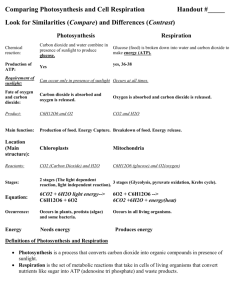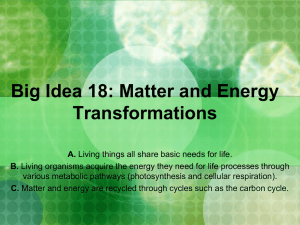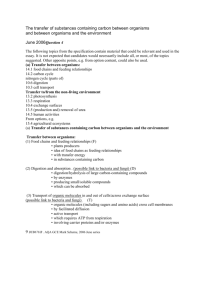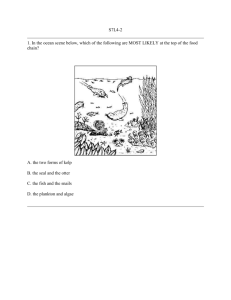TEKS 5.9B Describe how the flow of energy derived form the Sun
advertisement
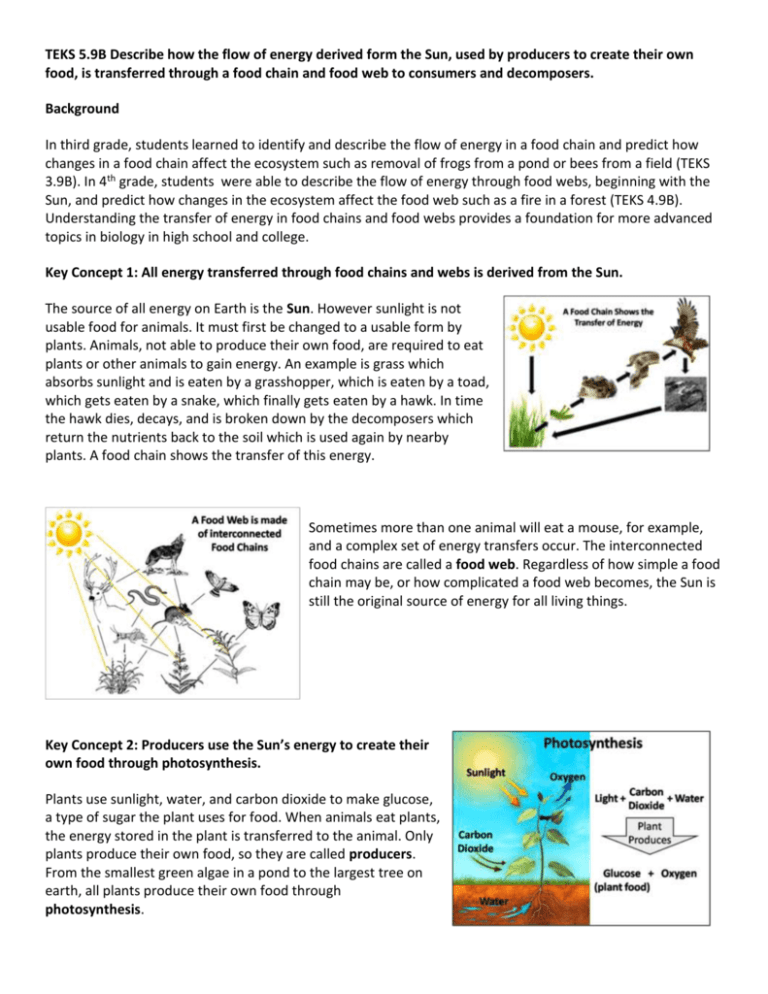
TEKS 5.9B Describe how the flow of energy derived form the Sun, used by producers to create their own food, is transferred through a food chain and food web to consumers and decomposers. Background In third grade, students learned to identify and describe the flow of energy in a food chain and predict how changes in a food chain affect the ecosystem such as removal of frogs from a pond or bees from a field (TEKS 3.9B). In 4th grade, students were able to describe the flow of energy through food webs, beginning with the Sun, and predict how changes in the ecosystem affect the food web such as a fire in a forest (TEKS 4.9B). Understanding the transfer of energy in food chains and food webs provides a foundation for more advanced topics in biology in high school and college. Key Concept 1: All energy transferred through food chains and webs is derived from the Sun. The source of all energy on Earth is the Sun. However sunlight is not usable food for animals. It must first be changed to a usable form by plants. Animals, not able to produce their own food, are required to eat plants or other animals to gain energy. An example is grass which absorbs sunlight and is eaten by a grasshopper, which is eaten by a toad, which gets eaten by a snake, which finally gets eaten by a hawk. In time the hawk dies, decays, and is broken down by the decomposers which return the nutrients back to the soil which is used again by nearby plants. A food chain shows the transfer of this energy. Sometimes more than one animal will eat a mouse, for example, and a complex set of energy transfers occur. The interconnected food chains are called a food web. Regardless of how simple a food chain may be, or how complicated a food web becomes, the Sun is still the original source of energy for all living things. Key Concept 2: Producers use the Sun’s energy to create their own food through photosynthesis. Plants use sunlight, water, and carbon dioxide to make glucose, a type of sugar the plant uses for food. When animals eat plants, the energy stored in the plant is transferred to the animal. Only plants produce their own food, so they are called producers. From the smallest green algae in a pond to the largest tree on earth, all plants produce their own food through photosynthesis. Key Concept 3: Consumers and decomposers get their energy from producers or other consumers. Some animal consumers get their energy by eating plant producers. Other animal consumers get their energy by eating other consumers (animals). Some animals eat both plants and other animals to obtain energy. (Decomposers such as bacteria and fungi, are organisms that break down dead organisms and their wastes to get energy.) Key Concept 4: The different parts of a food web are producers, consumers, and decomposers. In order to ensure a successful interactive ecosystem, there must be a proper balance in the populations of organisms within a food web. Any change in the population of any organism in the food web or food chain will affect other organisms. If all the grass in an area was killed in a wildfire, there would be less grass for the deer to eat and they could die off. If there were not enough deer to eat, then the predators (coyotes) would die off. If any population of organisms changes in some way, either increasing or decreasing, it will affect other organisms in the food web. Ultimately decomposers, through their chemical breakdown of the remains of dead plants and animals, return the nutrients in those decaying bodies back to the soil. This decaying material becomes soil “humus”, a rich organic material that supports plant growth and the food web continues. TEKS 5.9D Identify the significance of the carbon dioxide-oxygen cycle to the survival of plants and animals. Explanation: The interdependence of plants and animals is underscored when students study plant photosynthesis and animal respiration. Key Concept 1: People and animals exhale carbon dioxide during respiration. Most students know that blood flows in an animal’s body. One job of those thousands of blood vessels is to carry oxygen from the lungs to every cell, and then carry the discarded carbon dioxide waste from every cell back to the lungs where it is exhaled. Plants need this exhaled carbon dioxide for survival. Key Concept 2: Plants use carbon dioxide, water, and sunlight to produce their own food, releasing oxygen as a waste product. During photosynthesis, plants absorb sunlight and carbon dioxide through their leaves. There, a special chemical process combines the water absorbed by plant roots with the sunlight and carbon dioxide to produce glucose, a sugar plants use as food for growth. Plant cells release oxygen as a waste product into the air. This oxygen is needed by animals for survival. Key Concept 3: In order to survive, people and animals inhale the oxygen released by plants. Plants release oxygen into the air which animals inhale. During respiration, this inhaled oxygen is carried from the lungs by blood vessels to the heart which pumps the oxygen rich blood and other nutrients to each body cell for energy and growth. Plants also consume oxygen during respiration when they burn sugars to gain energy. Nature has provided an environment so that animals and plants can interact together to provide necessities that each need for survival. During the process of photosynthesis plants use sunlight, water, and carbon dioxide to produce food (glucose or sugar) and release oxygen. Animals breathe in that oxygen and use digested food to produce energy and carbon dioxide. Animals release carbon dioxide into the air, which plants use and the cycle starts again. The process by which animals and plants exchange gases is called the carbon dioxide/oxygen cycle. When this cycle is in balance, both plants and animals will be able to survive in an environment. The burning of fossil fuels has added an excess of carbon dioxide into the air.
